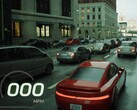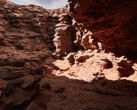Epic's Nanite rendering technology promised "unlimited" levels of detail, by scaling onscreen polygon counts to perfectly match what the camera can show at a given point of time and at a given resolution. While the Lumen in the Land of Nanite demo was impressive, a developer recently showcased Nanite in a more real world use case.
Melhem Sfeir imported a set of Quixel photogrammetry megascans called "Nordic Coastline," with several billion polygons into the Unreal 5 engine SDK. Nanite seemingly had no problem at all coping with massive number of triangles onscreen, seemingly delivering a fluid 1440p/60 FPS experience with a GeForce RTX 3070.
The visuals showcased were photorealistic - a step ahead of even the best environment rendering we've seen this generation, with individual beach pebbles realized with polygons instead of effects like normal and parallax occlusion mapping.
Nanite's ability to scale geometry LODs on the fly takes advantage of the ultra-fast SSDs found in both the PlayStation 5 and the Xbox Series X/S. If this technology becomes a pillar of ninth-gen visuals, it might spell the end of HDDs, which just aren't fast enough to enable effective streaming.












